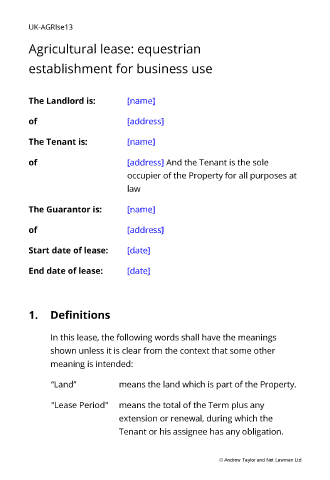Equestrian yard lease

Document overview

 England & Wales
England & Wales Scotland
Scotland

- Length:17 pages (6100 words)
- Available in:
 Microsoft Word DOCX
Microsoft Word DOCX Apple Pages
Apple Pages RTF
RTF

If the document isn’t right for your circumstances for any reason, just tell us and we’ll refund you in full immediately.

We avoid legal terminology unless necessary. Plain English makes our documents easy to understand, easy to edit and more likely to be accepted.

You don’t need legal knowledge to use our documents. We explain what to edit and how in the guidance notes included at the end of the document.

Email us with questions about editing your document. Use our Lawyer Assist service if you’d like our legal team to check your document will do as you intend.

Our documents comply with the latest relevant law. Our lawyers regularly review how new law affects each document in our library.
About this document
This is a lease of an equestrian establishment of any size.
The facilities could be limited to a single stable block or the most well equipped livery yard complete with indoor school, outdoor arena, other outbuildings and paddocks.
The term of the lease should be less than 7 years. The tenant could be either a private individual, or someone running a livery business.
This agreement has been drawn to include provision for the upkeep of agricultural land and specifically equestrian activities.
The law in this lease
This document creates a lease under the Landlord and Tenant Act 1954. Account has also been taken of:
the Landlord and Tenant (Covenants) Act 1995
the Regulatory Reform Regulations 2003
When to use this agreement
This lease is likely to be suitable:
whether the property is just a stable block with an adjacent field, or whether it has the most comprehensive set of equestrian facilities
where the term of the tenancy is between 6 months and 7 years
if the tenant will be responsible for maintaining the condition of the land and facilities
if the tenant is not a farmer or anyone who will grow crops or breed animals with a view to sale
This document does not allow for residential buildings on the land to be let - the tenant (or any employee) should not be allowed to live on site. If you require provisions for letting one of the buildings for residential purposes, use one of our separate assured shorthold tenancy agreements for that part of the property, or contact us to have suitable provisions included in the facilities lease.
The lease is not suitable if the tenant will breed horses or ponies for commercial reasons (i.e. run a stud). A farm business tenancy agreement should be used in this situation.
Agreement features and contents
This lease is comprehensive and provides alternatives for important choices. It contains 27 provisions and 1 schedule, including:
- the lease
- rent: amount and frequency, other payments, interest, review
- condition and repair
- tenant’s positive obligations
- restrictions on Tenant
- agricultural provisions
- competitions, vehicles and grassland damage
- signs and advertisements
- goods and vehicles
- default notice by Landlord
- assignment of the lease
- subletting not allowed
- tenant indemnifies landlord
- insurance
- security deposit
- access for Landlord
- guarantor
- provision for premature termination
- forfeiture
- security of tenure excluded
- schedule 1: rights reserved
Also included are extensive drafting notes that will help you edit the document for the exact deal you require.

Recent reviews
Very easy to edit for our specific use while retaining all necessary legal elements.
Follow-up query answered promptly.
If the occasion should arise again I will be pleased to refer to your service.
Choose the level of support you need
Document Only
This document
Detailed guidance notes explaining how to edit each paragraph
Lawyer Assist
This document
Detailed guidance notes explaining how to edit each paragraph
Unlimited email support - ask our legal team any question related to completing the document
- Review of your edited document by our legal team including:
- reporting on whether your changes comply with the law
- answering your questions about how to word a new clause or achieve an outcome
- checking that your use of defined terms is correct and consistent
- correcting spelling mistakes
- reformatting the document ready to sign
All rights reserved
